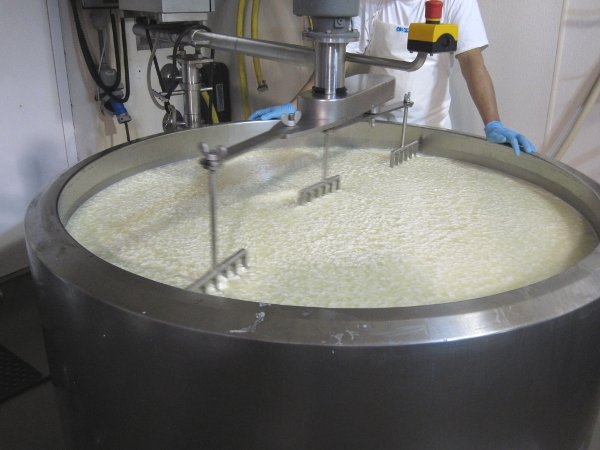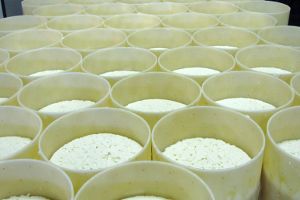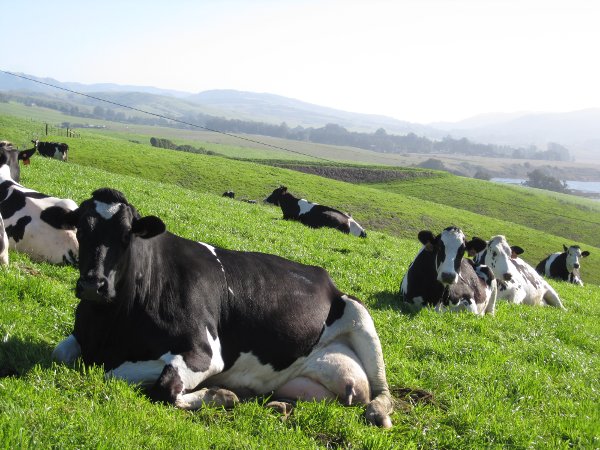I asked Cochennec what we’re missing.
[jwplayer config="QUEST Audio Player" skin="http://ww2.kqed.org/quest/wp-content/themes/quest/glow.zip" file="http://www.kqed.org/.stream/anon/radio/quest/2011/02/French Importer.mp3"]
Listen to Gildas Cochennec discuss the flavor of raw-milk vs. pasteurized milk cheese.
Meanwhile, for our radio story, we paid a visit to Point Reyes Farmstead Cheese Company, which is situated on 700 spectacular acres of farmland overlooking Tomales Bay.
Farmstead is best known for its award- winning Original Blue. Jill Giacomini-Basch -- one of four sisters who grew up here and, in 2000, returned to start the company -- says this cheese couldn't be made anywhere else.
“The milk here is really reflective of the climate, the grasses, the moderate temperature,” she says.
Every step involved in making this 20 dollar-a-pound blue cheese takes place here, in Point Reyes. The dairy's Holstein cows graze these fields, and every afternoon, their milk is pumped uphill to the make-house, where it’s mixed with cultures, blue mold, salt, and enzymes. Then the curds are poured into round plastic forms, salted, wrapped, and aged.
At no point is the milk pasteurized, or, heated to kill bacteria.
“Besides destroying the potential bad bacteria,” says head cheesemaker Kuba Hemmerling, pasteurization also destroys “the good bacteria. So obviously you take some of the flavors out of your cheese.”
The French have a word for this: terroir. It refers to the flavor of a particular place at a particular time of year. “I would call it more -- in a good way – farmy,” says Hemmerling. “You taste more of the farm, where the cows were, and what was happening.”
Selling raw, or unpasteurized, milk is illegal in most states. But, under federal law, raw-milk cheese is OK, as long as it’s been aged at least 60 days.
Here at Farmstead, the cheese is aged for about five months, well over that minimum. The idea is that the aging process both adds to the flavor and kills off harmful bacteria like e. coli O157-H7, which can make its way from an animal’s manure into its milk.
But in recent months, two recalls involving e. coli in raw-milk cheese have brought that law into question: in November, at Bravo Farms, near Fresno, then in December, at Sally Jackson Cheese, in Washington State.
David Acheson, a former associate commissioner for the U.S. Food and Drug Administration, says laboratory tests have suggested that e.coli O157, and possibly other microbes, as well, can survive the 60-day aging process.
“There’s real concern that the 60 days isn’t long enough,” he says.
On average, there are about 40 reported cases a year of people getting sick from raw-milk cheese, nationwide, according to the Centers for Disease Control. During a 15-year period between 1993 and 2008, two people died from those illnesses.
That's a small fraction of the outbreaks that have been traced back to ground beef, for example, and the number has stayed fairly constant. Still, the FDA says raw-milk cheese is a growing concern.
So, the agency is increasing inspections at creameries across the country and, officials there say, revisiting the science behind the 60-day rule.
Depending on what it finds out, the FDA could extend its minimum aging period. Or, it could follow the lead of Australia and Korea, and outlaw raw-milk cheese entirely.
Christine Hyatt, who heads the American Cheese Society says this scare over raw-milk cheese gives her a sense of déjà vu, to the early 2000s, when a series of cheese recalls created, she says, “a similar energy, or vibe, shall we say, in the industry.”
Those concerns died down, Hyatt says, once Americans realized that as much as a third of the cheese on supermarket shelves comes from raw milk.
“Parmigiano-Reggiano, Gruyere, Roquefort,” she lists, “they are all made with raw milk and have been for thousands of years.”
Hyatt says rather than outlaw raw-milk cheeses, the FDA should work with producers to make sure their facilities are as clean as possible.
The recalls, she says, have been a wake up call “that cheesemakers need to bump it up a notch. And I think a majority of our cheesemakers already do that, as evidenced by the fact that these issues don’t really surface that often.”
Before Jill Giacomini Bacsh and I take off our hairnets and plastic booties, which are required in the make-room, we step through what looks like a stream of bubbles that pulses onto the floor every ten minutes.
Giacomini Basch says precautions like these are life or death to her family's operation. The recalls are a reminder of just how easy it would be to lose this land whose flavors her family works so hard to preserve.
“You really can’t be too careful,” she says.
[jwplayer config="QUEST Audio Player" skin="http://ww2.kqed.org/quest/wp-content/themes/quest/glow.zip" file="http://www.kqed.org/.stream/anon/radio/quest/2011/02/2011-02-07-quest.mp3"]
Listen to the QUEST radio story Local Cheese Makers Fear a Raw Deal

38.17667141871774 -122.75161743164062


